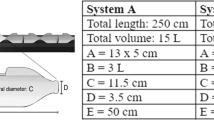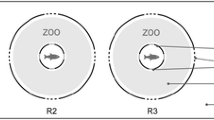Abstract
In this study, avoidance behavior of the freshwater cladoceran Daphnia magna Straus was used as indicator to assess the early stress of accidental organophosphorus pesticide (OP) contamination. The movement behavior was detected by a multi-species biomonitoring system. There was obvious concentration–response relationship between the OP stress and the behavioral response even at sublethal exposure. A rising OP stress resulted in a significant decrease of response time to escape (RTE; p<0.05). In comparison of different OPs, it was found that there was a power regression between RTE and the toxic unit of OPs. Therefore, the avoidance behavior of D. magna was a sensitive indicator of sublethal OP stress, and the power relationship could be used to predict the early warning thresholds of more OPs in the on-line biomonitoring system.






Similar content being viewed by others
References
APHA. (2001). Standard methods for the examination of water and wastewater, 20th edition. American Public Health Association, American Water Works Association, and Water Pollution Control Federation, Washington, DC 20005.
Capowiez, Y., & Berard, A. (2006). Assessment of the effects of imidacloprid on the behavior of two earthworm species (Aporrectodea nocturna and Allolobophora icterica) using 2D terraria. Ecotoxicology and Environmental Safety, 64, 198–206.
Christopher, M. T., David, J. S., & Matthew, J. W., (2001). Fluorinated phosphorus compounds: Part 4. A lack of anticholinesterase activity for four tris (fluoroalkyl) phosphates. Journal of Fluorine Chemistry, 107, 155–158.
Dortland, R. J. (1980). Toxicological evaluation of parathion and azinphosmethyl in freshwater model ecosystems. Agricultural Research Report, 898, 1–112.
Drastic, V., & Kubečka, J. (2005). Fish avoidance of acoustic survey boat in shallow waters. Fisheries Research, 72, 219–228.
Duquesne, S. (2006). Effects of an organophosphate on Daphnia magna at suborganismal and organismal levels: Implications for population dynamics. Ecotoxicology and Environmental Safety, 65, 145–150.
Erik, H., Finn-Arne, W., Joachim, S., Svante, W., & Holger, U. (2005). Avoidance behavior and brain monoamines in fish. Brain Research, 1032, 104–110.
Eriksson Wiklund, A.-K., Börjesson, T., & Wiklund, S. J. (2006). Avoidance response of sediment living amphipods to zinc pyrithione as a measure of sediment toxicity. Marine Pollution Bulletin, 52, 96–99.
Farr, A. J., Chabot, C. C., & Taylor, D. H. (1995). Behavioral avoidance of fluoranthene by fathead minnows (Pimephales promelas). Neurotoxicology and Teratology, 17, 265–271.
Gerhardt, A., Janssens, B., Mo, Z., Wang, C., Yang, M., & Wang, Z. (2002). Short-term responses of Oryzias latipes (Pisces: Adrianichthyidae) and Macrobrachium nipponense (Crustacea: Palaemonidae) to municipal and pharmaceutical wastewater in Beijing, China: survival, behavior, biochemical biomarkers. Chemosphere, 47, 35–47.
Gray, S., & Roff, D. A. (2000). Behaviour plasticity without learning: phenotypic and genetic variation of naive Daphnia in an ecological trade-off. Animal Behaviour, 59, 929–941.
Guilhermino, L., Lopes, M. C., Carvalho, A. P., & Soares, A. M. V. M. (1996). Inhibition of acetylcholinesterase activity as effect criterion in acute tests with juvenile Daphnia magna. Chemosphere, 32, 727–738.
Heupel, K. (2002). Avoidance response of different collembolan species to Betanal. European Journal of Soil Biology, 38, 273–276.
Hofmann, H. A., & Schildberger, K. (2001). Assessment of strength and willingness to fight during aggressive encounters in crickets. Animal Behavior, 62, 337–348.
ISO. (1996). Water Quality-Determination of the acute lethal toxicity of substances to a freshwater fish [Brachdanio rerio (Hamilton-Buchanan), Teleostei, Cyprinidae]—Part 3: Flow-through method. ISO/ DIS 7346/3.
Jury, S. H., Kinnison, M. T., Huntting, H. W., & Watson, W. H. (1994). The behavior of lobsters in response to reduced salinity. Journal of Experimental Marine Biology and Ecology, 180, 23–37.
Kikuchi, M., Sasaki, Y., & Wakabayashi, M. (2000). Screening of organophosphate insecticide pollution in water using Daphnia magna. Ecotoxicology and Environmental Safety, 47, 239–245.
Lampert, W. (1993). Phenotypic plasticity of the size at first reproduction in Daphnia: The importance of material size. Ecology, 74, 1455–1466.
Maltby, L., Kedwards, T. J., Forbes, V. E., Grasman, K., Kammenga, J. E., Munns, W. R., et al. (2001). Linking individual-level responses and population-level consequences. In D. J. Baird & G. A. Burton Jr. (Eds.) Ecological variability: Separating natural from anthropogenic causes of ecosystem impairment (pp. 27–82). Pensacola, FL, USA: SETAC.
Ren, Z. M., Ma, M., & Wang, Z. J. (2006). On-line biomonitoring of accidental drinking water organophosphorous pesticides contamination. Water & Wastewater Engineering, 32, 17–20.
Reynaldi, S., Duquesne, S., Jung, K., & Liess, M. (2006). Linking feeding activity and maturation of Daphnia magna following short-term exposure to fenvalerate. Environmental Toxicology and Chemistry, 25, 1826–1830.
Riddell, D. J., Culp, J. M., & Baird, D. J. (2005). Behavioral responses to sublethal cadmium exposure within an experimental aquatic food web. Environmental Toxicology and Chemistry, 24, 431–441.
Rosa, E., Barata, C., Damasio, J., Bosch, M. P., & Guerrero, A. (2006). Aquatic ecotoxicity of a pheromonal antagonist in Daphnia magna and Desmodesmus subspicatus. Aquatic Toxicology, 79, 296–303.
Sager, D. R., Hocutt, C. H., & Stauffer Jr., J. R. (2000). Avoidance behavior of Morone americana, Leiostomus xanthurus and Brevoortia tyrannus to strobe light as a method of impingement mitigation. Environmental Science & Policy, 3, 393–403.
Sandbacka, M., Christianson, I., & Isomaa, B. (2000). The acute toxicity of surfactants on fish cells, Daphnia magna and fish—A comparative study. Toxicology in Vitro, 14, 61–68.
Scarfe, A. D., Jones, K. A., Steele, C. W., Kleerekoper, H., & Corbett, M. (1983). Locomotor behavior of four marine teleosts in response to sublethal copper exposure. Aquatic Toxicology, 2, 335–353.
Selye, H. (1973). The evolution of the stress concept. American Scientist, 61, 692–699.
Steele, C. W., Strickler-Shaw, S., & Taylor, D. H. (1989). Behavior of tadpoles of the bullfrog, Rana catesbeiana, in response to sublethal lead exposure. Aquatic Toxicology, 14, 331–343.
Sturm, A., & Hansen, P. D. (1999). Altered cholinesterase and monooxygenase levels in Daphnia magna and Chironomus riparius exposed to environmental pollutants. Ecotoxicology and Environmental Safety, 42, 9–15.
Untersteiner, H., Kahapka, J., & Kaiser, H. (2003). Behavioral response of the cladoceran Daphnia magna STRAUS to sublethal Copper stress—validation by image analysis. Aquatic Toxicology, 65, 435–442.
USEPA. (2000). Pesticide Ecotoxicity Database [Formerly: Environmental Effects Database (EEDB)]. Office of Pesticide Programs. Environmental Fate and Effects Division, Washington, DC 20005.
Acknowledgments
The work was supported by Natural Science Foundation of China (20621703, 20337020) and Natural Science Foundation of Beijing Municipality (8061004).
Author information
Authors and Affiliations
Corresponding author
Rights and permissions
About this article
Cite this article
Ren, ZM., Li, ZL., Zha, JM. et al. The Avoidance Responses of Daphnia magna to the Exposure of Organophosphorus Pesticides in an On-Line Biomonitoring System. Environ Model Assess 14, 405–410 (2009). https://doi.org/10.1007/s10666-007-9136-0
Received:
Accepted:
Published:
Issue Date:
DOI: https://doi.org/10.1007/s10666-007-9136-0




